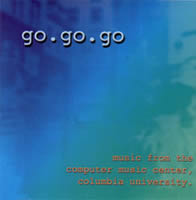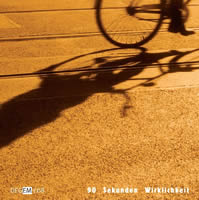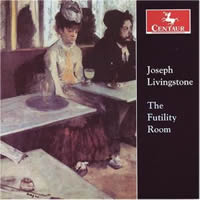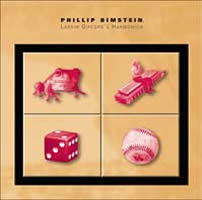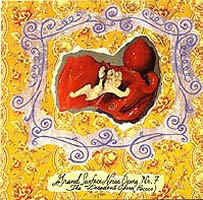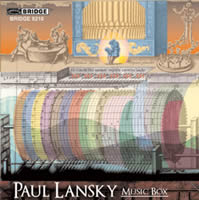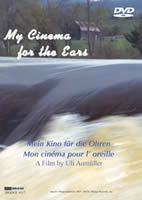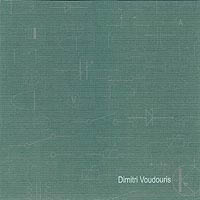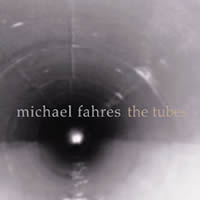EA Bucket 5.
|
Grant Chu Covell [June 2007.] Like others I’ve submitted to this august journal, the present electroacoustic roundup began as a shuffle through recent acquisitions. As items piled up next to my player, I sensed a pattern — indeed a trend demanding reconsideration. (The stuff I seek out represents a narrow wedge of the ea industry and doubtless reflects directions I’m keen on.) In our post-everything era, we seem to be awash in historical electroacoustic music in large measure created in pre-digital days, with and without instruments, and again in large measure, reflecting chaos and sweat. Anyone who has worked with early synthesizers knows what beasts they can be. Open the soundproofed door to air out a clammy studio? Why then, look forward to a change in humidity that often mucks up the circuitry. Bouncing tracks with open-reel decks is an art made all the more arduous as the adrenalin drains away. Digital technology makes electroacoustic music far easier to create, a lot more repeatable, and often more mundane, with almost every keyboard programmed with the same 101 samples. Late-night fiddling with a Putney or Moog’s temperamental knobs is very much a relic of the past. A lot of recent releases finish a distant second to works from the 1960s and 1970s. Scale is the most dramatic difference. Intentionally or not, newer works rarely run as long as those created decades ago. Apart from the fact that many of today’s composers haven’t the chops for extended pieces, I can see two other compelling reasons for the fall-off in quality. Nowadays everyone is a composer. For academic departments and festivals to accommodate the abundance, time limits must be set. I saw this firsthand when I tried to break into the circuit. Secondly, technology’s ubiquity has brought classical ea much closer to pop, where the four-minute “song” dominates. Another difference between new and old ea: Many composers who write pure ea (music without instruments or a live performance component) have no concept of audience. It’s just not natural for listeners in a live setting to see loudspeakers on a stage. What are they applauding when the piece is over — the speaker enclosures? Recall that Varèse’s Poème Electronique was written for Xenakis’ architecture. New music often requires new modes of presentation. When ea tells stories, the model of storyteller / broadcaster and listener / receiver still works in a concert hall. If the music includes live musicians, one wants to watch. It’s human nature. In this regard, the audience / stage paradigm works. As earlier mentioned, more folks are creating ea than ever before. As earlier hinted, most of them have nothing to say. The cleverest among the throng stand out by resorting to gimmicks. Creating ea has become too easy, and it shows. User-friendly tools don’t equate better music. Much of today’s ea consists of marginal composers striving for proficiency with a new gadget. Much of this stuff operates as ads for well-equipped studios. Electroacoustic nostalgia is on the rise. Old technology abounds. We hear old TV and radio show themes quoted, filtering that mimics drive-in theatre sound, the incorporation of pre-digital artifacts, e.g., phonograph styli skating across discs. Do I suggest that the genre is at an impasse? I’m guilty of having used similar effects but like to think they contribute to a mood rather than operating as the music’s sole purpose. The worst of such nostalgia plays as collage-like tricks innocent of meaningful creativity. I cover one class of releases in this bucket. Next will be an installment featuring historical issues, and following that a batch including Ferrari, Mazulis, Murail, Saariaho, Grisey and Radulescu. It’s completely by chance that the last four I’ve listed are spectralists, and yet the coincidence has set me to thinking….
“go.go.go: Music from the Computer Music Center, Columbia University.” Var. composers. (http://music.columbia.edu/cmc/gogogo_cd/). “90 Sekunden Wirklichkeit.” Var. composers. Cybele 960.208 / DEGEM CD8 (http://www.cybele.de/). Distributed in the US by Albany Music Distributors / ArkivMusic (http://www.arkivmusic.com/). The sampler from Columbia University’s Computer Music Center offers 16 tracks, none longer than six minutes. The composers flaunt baubles, nothing more. It’s not clear if some are excerpts. The skimpy notes include unhelpful credentials and too few clues about the music. While it’s obvious that the CMC’s composers have tools and toys (they’re the Columbia-Princeton Electronic Music Center founded in 1958 by Ussachevsky and Luening), I’d like to hear what some of them would do within far lengthier time spans. Douglas Geers, R. Luke DuBois, Oliver Schneller and Dan Trueman work with instruments or live performers, with varied results. Terry Pender, Tim Polashek, Marcus Alessi Bittencourt and Ramin Amir Arjomand employ layered speech or primal vocalizations as a springboard for some, a crutch for others. Chris Bailey’s opening track is precisely the type of nostalgic collage that so frustrates me: cute snippets quoting old Batman shows tumble among blips and blurts. Empty calories. This sampler provides a generous hint of today’s ea trends. Your move. The tracks can be downloaded as mp3s. I’d certainly welcome CMC discs focusing on fewer composers. I thank Tower Records’ dissolution for 90 Sekunden Wirklichkeit. Then again, anything on Cybele or sponsored by Deutscher Musikrat is a good risk. This disc houses 47 ninety-second ea tracks, the communal theme: reality (“Wirklichkeit”). Some cuts feature zippers, LP deadtracks, cutting glass, the winning goal’s jubilation, wind turbines, etc., making for a stimulating name-that-theme game. Others are constructed like op-ed pieces, such as the curtain-raiser, a sly collage of news-show theme music. Here I’ve no beef with brevity. The disc’s rationale is durational constraint, the short format ensuring snappy efforts leaving little room for boredom, except for two contributions that riff unconvincingly on the disc’s title.
“The Futility Room.” Joseph LIVINGSTONE: Asst. compositions. Centaur CRC 2842 (http://www.centaurrecords.com/). Distributed in the US by Qualiton (http://www.qualiton.com/). “Larkin Gifford’s Harmonica.” Phillip BIMSTEIN: Casino (1997); Half Moon at Checkerboard Mesa (1997); The Bushy Wushy Rag (2000); Rockville Utah 1926 (1997); Larkin Gifford’s Harmonica (2001). Sierra Winds, Stephen Caplan (ob), Equinox Chamber Players, Abramyan String Quartet. Starkland ST-214 (http://www.starkland.com/). Livingstone’s disc is an enjoyable collage hash employing modest percussion passages, tonal backgrounds and absurdist gestures. At first I thought he was merely a collector. It turns out he’s a raconteur. The 10 tracks (Uncreate, The Aloner School, Upon the Ground, 1321, The Moon Gardener, The Futility Room, In the Decline, The Damage Letters, The Romance Languages, Verloren) suggest a restless traveler’s thwarted voyage. I had the frequent impression of looking out a tour-bus window and glimpsing something that warranted further interest but could not investigate. Glib, simplistic notes accompany Livingstone’s uncomplicated mission. No individual composition dates are provided and it’s unclear whether the ten tracks are intended as one entity. They work well as a sequence. There’s also good glue between the briskly moving sections, the tasteful distortions, gentle retro gestures and easygoing pace. The title piece (the release’s shortest) offers a soundtrack to the café of Degas’ The Absinthe Drinkers, with an intermingling of pump-room ambience and steel drum. While I can’t pretend to understand what Livingstone is driving at, I enjoyed the obscure narrative. Affably goofy and sanguine, Bimstein is an old hand at telling stories and creating locales. For his second Starkland release, he captures a casino’s sticky allure, the starry ambience of Zion National Park and a charismatic beer vendor at St. Louis’ Busch stadium. Bimstein’s methods are simple and traditional. Where there are accompanying instruments, a wind quintet in Casino and Bushy Wushy Rag and a solo oboe in Half Moon, he employs a reassuring, easy-to-follow tempo. Larkin Gifford’s Harmonica tells the story of a man and his favorite instrument. The nostalgic Rockville Utah 1926 for string quartet (no tape) revisits material from Bimstein’s 1990 Garland Hirschi’s Cows (Starkland ST-205), concentrating now on the year and place of the farmer’s birth. As with Casino and Bushy Wushy Rag, Bimstein works wonders cutting and pasting his subjects’ words. Tonal backgrounds and concrète snippets weave and bounce through major and minor, as comforting as warm apple pie.
Crawling With Tarts a.k.a. Michael GENDREAU and Suzanne DYCUS-GENDREAU: Ochre Land, Blue Blue Skies (1996-97, ver. 1998); Grand Surface Noise Opera Nr. 7: The Decadent Opera (Rococo) (1994, ver. 1996-97). Pogus P21039-2 (http://www.pogus.com/). Yoav GAL with Yael Kanarek: Bit by Bit, Cell by Cell (2006). Sarah Rivkin (sop). Innova 647 (http://www.innova.mu/). Enhanced CD contains a QuickTime Movie which accompanies the first track. Pogus’ Crawling with Tarts release consists of two extended atmospheric washes, recalling late-night college radio collages. Notes, details and cover art are purposefully oblique. The 34-minute Ochre Land, Blue Blue Skies arranges a life’s detritus: something that sounds like a shoulder strap squeaking while walking, wind chimes, radio static, the ubiquitous hum of comfort-giving electronic appliances, and so forth. Amplified sounds are gently blended and then discarded. Grand Surface Noise Opera Nr. 7: The Decadent Opera (Rococo) is more humorous, a generous lasagna featuring all sorts of mid-20th-century “found” sounds, such as language instruction recordings, stenographic dictation examples, radio and even a bit of Wagner’s Ring, eventually jettisoned for a bout of industrial noise leading to a toy piano, and so on. Neither piece makes for good focused listening, but operates nicely as quirky backdrop. I’m always amazed that this genre continues to exist. Unless you have no short-term memory, this is the kind of thing that works best, if it works at all, first time around. Gal and Kanarek contrive an unsettling universe. Kanarek’s cryptic story unfolds through a traveler’s postcards. Gal’s music extends Rivkin’s serenely innocent soprano with campy processing and gushy electronics, his only tool being an ancient Atari 800XL. Taken together, the audio, the booklet, the enhanced CD’s video and the online site (http://www.worldofawe.net/), Gal and Kanarek lay out a puzzling mystery in a parallel universe utterly askew. The short track “Grid” ranks high amidst techno-minimalist chatter, à la Reich and Lentz. Gal’s artfully constructed retro score achieves more than the work of many who compose with up-to-date gear.
“Mother of Balloon Music.” Judy DUNAWAY: Two Etudes for Balloon and Violin (2004); For Balloon and String Quartet (2001); The Balloon Factory (2004-06); For Bass Koto with Balloons (2000); The Rubber Forest (2004-06). Judy Dunaway (balloons); Tom Chiu (vln); FLUX Quartet; Ryuko Mizutani (koto); Damian Catera (electronics). Innova 648 (http://www.innova.mu/). “Music Box.” Paul LANSKY: Asst. compositions. Bridge Records 9210 (http://www.bridgerecords.com/). Yes, the lady plays with balloons. Call me a prude, I don’t think I’d like to see this live. Two improvisatory etudes for Dunaway and violinist Chiu investigate her instrument’s potential, whether rubbed, vibrated or mimicking reed instruments. The three-movement quintet joins strings with amplified balloons aping an electric guitar spinning out glissandos. (Perhaps after conquering Feldman, the FLUX is at a loss.) Other works, including a piece for “prepared” koto (prepared with balloons, of course!), shroud their sources. Weird. Who knew that within latex lurks such potential? Bridge offers ten of the versatile Lansky’s recent amusements. The briefer compositions — Wordless, PassaKaglia and Music Box — unfurl like harmless remnants. Intellectual pursuits they are not, nor are there subtexts. Lansky’s groundbreaking 1978-79 Six Fantasies on a Poem by Thomas Campion have endeared me to his work. No amount of goofing can shake my fondness loose. Chatter of Pins extends the coy wordplay pieces (in the “chatter” series) by clustering and obscuring syllables over a gentle, tumbling beat. With their retro chord progressions and gushy sampler backgrounds, pieces like Pavane Noir are simply strange, as if Lanksy has deserted Princeton for Miami. Some tracks do show evidence of cerebral activity. I’m convinced Two by Two conceals a hidden message, whereas the Composition Project for Seniors — referring to students, not the elderly — juggles chords. Annoying at first, The Joy of F# Minor explores a slow progression against a ticking clock.
And now for something completely different. I’ve been meaning to mention the breathtaking DVD, My Cinema for the Ears (Bridge 9117), which chronicles Francis Dhomont and Lansky as they create electroacoustic music. Uli Aumüller’s movie does an amazing job of describing the compositional process. If ever you wanted to understand ea, this is the DVD for you.
Dimitri VOUDOURIS: NPFAI.1 (2002); Palmos (2002); NPFAI.3 (2003); Praxis (2004). Pogus P21043-2 (http://www.pogus.com/). “The Tubes.” Michael FAHRES: Sevan (2000/03); The Tubes (1994/2003); Coimbra 4, Mundi Theatre (2004/06). Parik Nazarian (voice), Jon Hassell (trpt), Mark Atkins (didgeridoo). Cold Blue Music CB0024 (http://www.coldbluemusic.com/). Born in Greece but now working in South Africa, Voudouris’ leisurely progressing pieces raise the image of delicate giants. In NPFAI.1 (New Possibilities for African Instruments), we hear the kundi and m’bira and an African marimba in NPFAI.3. Suggestions of Schaeffer’s early foolery at concrète’s infancy commingle with eerie Tudor landscapes as Voudouris filters percussive sounds through his digital sandbox. Palmos is an unhurried exploration of sinusoidal contours. Working with fewer source materials, NPFAI.3 deftly organizes clever and engaging episodes. There’s much to admire in these pieces. I hear Praxis, which uses choir and computer processing, as the clear winner. Praxis’ source is an inadvertently damaged tape of an Eastern Rite memorial service in Johannesburg commemorating victims of the mid-1990s Croatian genocide. Distorted voices, bells and speech whirl through a work neither sanctimonious nor apocalyptic, but heartfelt and compassionate. Two smart travelogues surround Fahres’ disc’s extended and less interesting title piece. The first brings attention to the frail ecology of Lake Sevan in Armenia; the last juggles sounds from a Portuguese festival. A tedious rhapsody built upon sounds recorded at El Hierro in the Canary Islands separates them. With its crashing surf and processed trumpet and didgeridoo, The Tubes does little to elevate these clichés: 30-plus minutes of Swiss cheese. An infestation of fire ants upon anyone who thinks he has something of interest to say with electronically manipulated didgeridoo.
[More EA Bucket, Grant Chu Covell]
[Previous Article:
King John IV of Portugal: Discography of Joao IV (1604-1656)]
[Next Article:
Pièces de Clavecin 2: Jean-Philippe Rameau]
|
